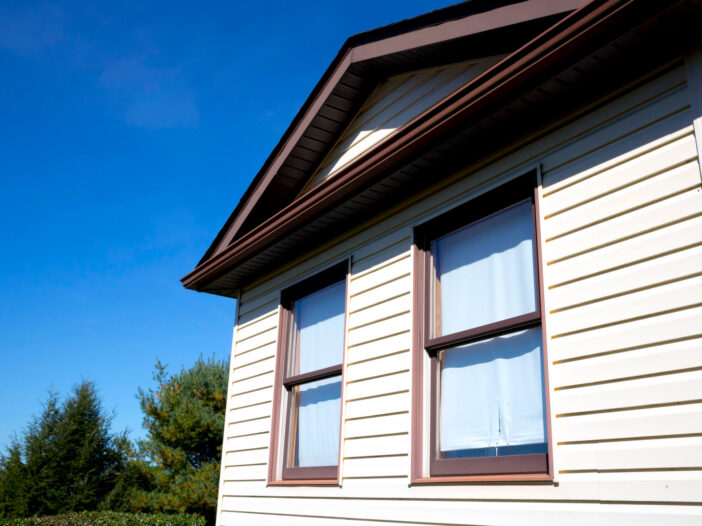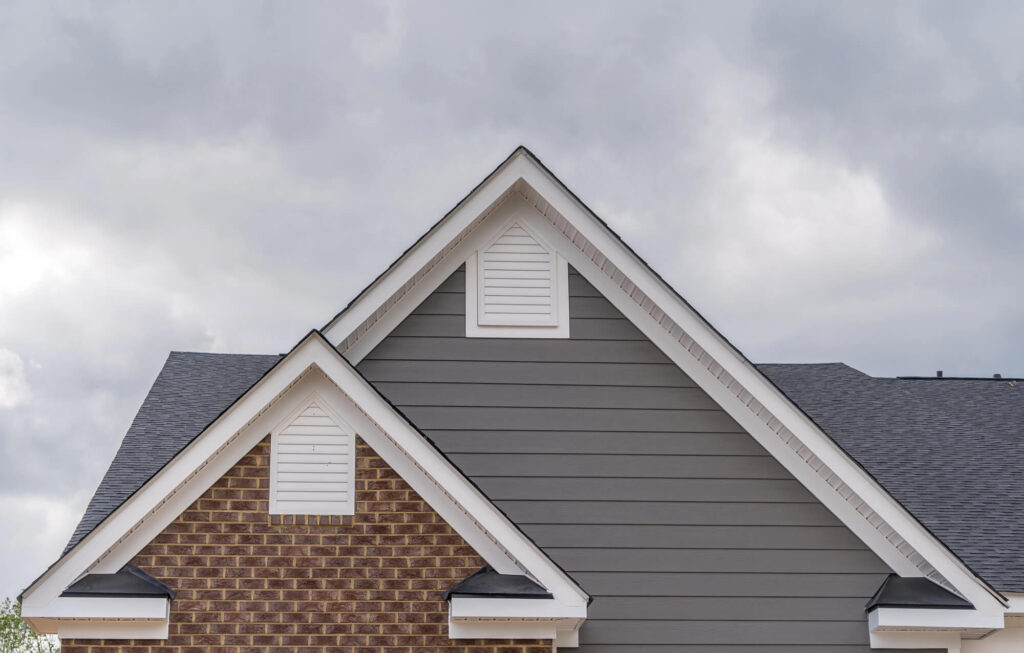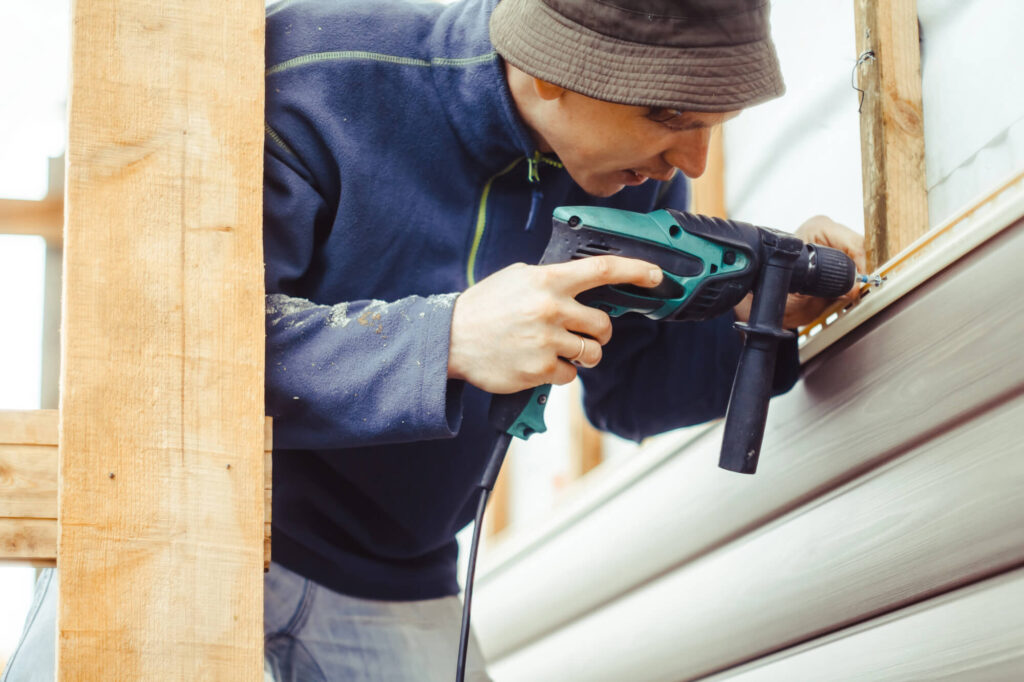
Your home’s exterior does more than enhance its appearance—it plays a critical role in protecting the structure, improving comfort, and contributing to long-term energy efficiency. Among the many elements of a home’s exterior, siding is one of the most impactful, serving as both a protective barrier and a design statement. However, as more homeowners prioritize eco-friendly home renovation projects, the choice of siding material has shifted toward sustainable siding solutions that reduce environmental impact while giving you significant energy savings.
In this guide, we’ll explore the environmental benefits of sustainable siding materials, how siding in general can support a home’s energy efficiency, and why products like James Hardie Fiber Cement Siding and LP SmartSide® Engineered Wood Siding are leading the residential market in eco-friendly home exterior solutions.
Whether you’re upgrading your property for resale value, improved comfort, or long-term durability, choosing the right siding contractors and installation techniques can make a significant difference for your home and the planet.
What Makes Siding Materials “Sustainable”?
Not all siding materials fare the same when it comes to environmental impact. Sustainable siding materials should minimize the strain on natural resources while improving the overall performance of a home. Key characteristics of sustainable or eco-friendly siding include:
- Responsible sourcing: Siding can come from renewable resources, like engineered wood siding, which can be Forest Stewardship Council (FSC) certified, ensuring that raw materials come from responsibly managed forests.
- Long lifespan and durability: High-quality materials like fiber cement or metal siding reduce waste by lasting decades before needing replacement and offering insulation properties that improve energy efficiency.
- Minimal environmental footprint in manufacturing: Modern processes, such as electric arc furnace production using recycled ferrous scrap for recycled steel siding, minimize emissions.
- Recyclability: At the end of their life cycle, many siding options, like metal siding, composite siding, or some types of vinyl siding, can be recycled rather than sent to landfills.
Choose eco-friendly siding materials, and you, as a homeowner, will contribute to reducing greenhouse gases associated with production, transportation, and disposal, while benefiting from materials that are built to last.
Overall Environmental Benefits of Home Siding
Sustainable siding does more than protect your home—it enhances its energy efficiency, lowers operating costs, and supports green building practices.
Improved Energy Efficiency and Insulation
High-performance siding acts as a thermal barrier, reducing the need for your HVAC system to work overtime. Proper siding installation and insulation layers help maintain stable indoor temperatures, improving R-values (the measure of thermal resistance) and reducing heat transfer.
- Fiber cement siding and engineered wood siding can be paired with high-quality insulation for excellent energy-efficient siding performance.
- Vinyl siding with insulated backings adds another layer of protection against heat loss or gain.
- In hot climates like San Antonio, siding with reflective coatings supports passive cooling systems, lowering energy bills and reducing reliance on non-renewable energy sources.
According to the U.S. Department of Energy, improving your home’s exterior envelope, including walls and siding, is one of the most cost-effective ways to reduce energy waste and cut greenhouse gas emissions.
Longevity and Durability Reduce Waste
Choosing siding with a long service life minimizes the need for frequent replacements, conserves natural resources, and lowers your carbon footprint. Materials like James Hardie fiber cement siding are designed to resist storm damage, rot, pests, and fading, lasting decades with minimal upkeep. Similarly, LP SmartSide® engineered wood siding combines the warmth of cedar wood with advanced treatments for resistance to fungi, termites, and moisture decay.
Long-lasting siding reduces the impact of replacement materials on production, transportation, and disposal, supporting sustainable building practices.
Protection Against Moisture and Structural Damage
Properly installed siding prevents water intrusion, mold growth, and structural decay, extending the life of your home’s frame and insulation layers. This reduces the need for chemical treatments, unnecessary repairs, or early reconstruction, all of which have environmental costs.
Soundproofing and Indoor Comfort
High-quality siding materials also improve soundproofing, reduce noise pollution, and enhance indoor living conditions. A quieter home environment contributes to improved well-being without adding energy-consuming solutions.

Eco-Friendly Siding Materials and Their Benefits
Modern residential siding contractors offer a wide variety of eco-friendly siding, alongside traditional siding materials, which suit different styling preferences, climatic conditions, and budgets.
Fiber Cement Siding – James Hardie
- Composition: A mix of cement, sand, and cellulose fibers, making it highly durable and fire-resistant.
- Environmental advantages:
- A long lifespan (up to 50 years or more) reduces landfill waste.
- Low maintenance compared to natural wood or vinyl siding, requiring fewer repainting cycles.
- James Hardie siding is known for cutting-edge technology, providing impact resistance, pest protection, and protection from Texas’s local climate challenges such as humidity and high heat.
- Benefit to homeowners: High resale value, energy-efficient properties, improved property value, and peace of mind knowing the product resists storm damage, rot, and pests while reducing energy loss.
Engineered Wood Siding – LP SmartSide®
- Appearance: Captures the natural warmth of cedar wood siding with customizable finishes for aesthetic diversity.
- Durability: Treated with SmartGuard technology to resist decay, termites, and moisture-related damage.
- Sustainability: Made from renewable wood fibers combined with synthetic resins for strength, reducing the need for harvesting old-growth forests.
- Performance: With proper installation techniques, LP SmartSide® enhances insulation, lowers heating and cooling expenses, and withstands climatic shifts better than traditional wood.
- Benefit to homeowners: A cost-benefit analysis shows long-term savings due to fewer repairs, low maintenance, and increased curb appeal.
Metal Siding (Aluminum Siding or Steel Siding)
- Environmental benefit: Often made with recycled metal, reducing mining impact and greenhouse gas emissions.
- Durability: Recycled metal siding can be resistant to fire, pests, and climatic shifts, making it ideal for long-term sustainability.
- End-of-life recyclability ensures minimal landfill waste.
- Popular for modern styling options, especially for homeowners seeking sleek, industrial looks with high longevity.
Vinyl Siding (Recycled Options)
- While not as eco-friendly as fiber cement or engineered wood, modern vinyl siding can be made with recycled polyvinyl chloride (PVC) materials.
- Offers affordable energy-efficient siding options when paired with insulation backing.
- Lightweight material reduces transportation emissions, though it has a shorter lifespan than premium alternatives.
Brick and Masonry Options
- Brick siding provides long-lasting durability with minimal environmental impact over decades.
- Sourced locally, brick and masonry siding reduces transportation emissions.
- Excellent thermal mass properties contribute to energy efficiency in fluctuating climates.
- Add to an overall sustainable home construction.

How Siding Installation Contributes to Sustainability
Even the best materials depend on proper siding installation techniques to achieve maximum benefits:
- Tight sealing and weather barriers improve R-values and prevent air leaks.
- Professional residential siding contractors ensure correct alignment and fastening, preventing future warping or gaps that compromise insulation.
- High-quality installation supports passive cooling, complements solar panels, and minimizes reliance on HVAC systems, reducing overall carbon emissions.
- Correct techniques also extend siding longevity, preserving your investment and property value.
Choosing the Right Sustainable Siding for Your Home
When selecting eco-friendly siding, consider:
- Local climate (hot summers, heavy storms, and humidity in San Antonio).
- Material sourcing and certifications, such as FSC or Leadership in Energy and Environmental Design (LEED) compliant products.
- Durability, maintenance needs, and long-term cost-benefit analysis.
- The aesthetic match to your home’s architecture and neighborhood styling trends.
With American Windows and Siding, you gain access to industry-leading James Hardie Fiber Cement Siding and LP SmartSide® Engineered Wood Siding, installed by experienced siding contractors committed to high-quality workmanship and sustainable building practices.
Why Choosing Sustainable Siding is a Smart Investment for Your Home and the Planet
Choosing sustainable or eco-friendly siding options is one of the smartest moves homeowners can make for the environment, their comfort, and their wallet. From energy efficiency and insulation improvements to a reduced carbon footprint, siding directly impacts your home’s durability, resale value, and long-term sustainability.
Premium products like James Hardie Fiber Cement Siding and LP SmartSide® Engineered Wood Siding offer unbeatable longevity, low maintenance, and eco-friendly benefits for San Antonio’s challenging climatic conditions. By working with residential siding contractors who use the best installation techniques, you can ensure your siding performs optimally for decades.
For expert guidance, sustainable material options, and professional siding installation, contact American Windows and Siding today—and take a step toward a greener, more energy-efficient home that’s built to last.









